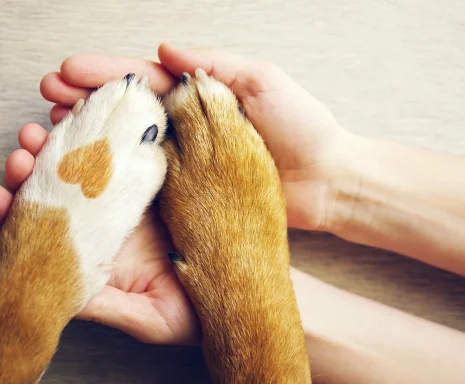Purchase Affordable Pet Insurance
Safeguard Your Pet with Ease
The Road to Pet Health Starts Here!
If you’re a pet parent, you’re well aware of the high cost of veterinary bills, but you also know it is essential and valuable to maintain your pet’s care.
Your pet is a cherished member of your family and deserves the best care available. A standard pet health insurance policy can help offset some of those expenses, saving you from making tough decisions about denying medical treatment. In the rare case of a serious accident or injury, a comprehensive insurance plan can ensure your furry friend is well protected.
At Acceptance Insurance, we’re committed to finding affordable solutions to provide the best care for your pets when they need it most. Plus, signing up online takes less than a minute!

How Does Pet Insurance Work?
Unlike traditional health insurance for people, pet insurance requires you to pay for veterinary services up front and then get reimbursed. This means you’re responsible for covering the costs initially but can manage unexpected expenses more effectively with insurance. Here’s a basic rundown of how it works:
- Choose a Plan: Pick an insurance policy that matches your pet’s needs and fits your budget. Coverage options can vary and may include protection for accidents, illnesses, routine care, and more.
- Pay Monthly Premiums: To keep your pet insured, you’ll pay a monthly premium. The amount will depend on factors such as your pet’s age, breed, and the chosen coverage options.
- Visit the Vet: When your pet needs medical attention, you’ll pay the vet directly. While some policies might have network restrictions or preferred veterinarians, our partnership with ASPCA Pet Health Program means you can see any licensed vet, specialist or emergency clinic in the U.S.
- Submit a Claim: After settling the vet bill, file a claim with ASPCA. This typically involves completing a form and submitting a copy of the invoice.
- Receive Reimbursement: Once your claim is processed, the insurance company will reimburse you for a portion of the expenses, usually between 70% and 90%, minus any deductibles.
- Understand Deductibles and Limits: Most policies have an annual deductible, which is the amount you pay out-of-pocket before coverage begins. There may also be annual limits or caps on coverage per condition.
With pet coverage, you can manage unforeseen veterinary costs and ensure your pet receives the care it needs without financial stress.
What is the Cost of Pet Insurance?
Pet insurance costs can vary significantly, from under $10 to more than $100 per month. This wide range is due to the unique needs of each pet, influenced by factors such as species, age, breed, location, and coverage options.
At Acceptance, we recognize that you want the best coverage for your dogs and cats while staying within budget. Our pet insurance plans are designed to be flexible, allowing you to customize coverage to suit both your pet’s needs and your financial constraints.
Ready to Get a Quick Quote?
What Does Pet Insurance Cover?
You know your pet and your budget best. That’s why the ASPCA Pet Health Insurance program offers customizable plans to fit your unique situation. You can choose from two options, Complete Coverage ℠ (accident and illness) or Accident Only plans, and you can add a preventive care plan to your policy for just a little bit more per month.
Pet insurance plans can be customized to fit your unique situation, as well. Work with an agent to help you find the plan that best fits your needs and wallet.
Acceptance Insurance is proud to partner with the ASPCA Pet Health Insurance program to offer affordable pet insurance
What Do Pet Insurance Plans Cover?
You know your pet and your budget best. That’s why the ASPCA Pet Health Insurance program offers customizable plans to fit your unique situation. You can choose from two options, Complete CoverageSM (accident and illness) or Accident Only plans, and you can add a preventive care plan to your policy for just a little bit more per month.
Most cat and dog owners want the best for their trusty companion. If you’re considering purchasing a pet protection plan, let our friendly neighborhood Acceptance agents do some comparison shopping to determine the ideal plan for your pet’s needs. The following are the most common types of pet insurance plans.

- Wellness exams
- Fecal or parasite tests
- Heartworm tests
- Bloodwork
- Vaccines
- Dental cleanings
- Flea/tick/heartworm medication insurance
Complete Coverage
Our Complete Coverage is a comprehensive pet insurance plan offered by the American Society for the Prevention of Cruelty to Animals (ASPCA). This plan typically includes:
- Accidents & injuries – Broken bones, sprains, muscle or tendon injuries, puncture wounds
- Common illnesses – Infections, vomiting, diarrhea
- Serious illnesses – Cancer, heart disease, diabetes
- Chronic illnesses – Skin conditions or arthritis
- Hereditary conditions – Blood & thyroid disorders, hip dysplasia
- Testing & diagnostics – X-rays, CT scans, MRIs
- Procedures – Surgery, chemo, endoscopy
- Holistic & alternative care – Acupuncture, chiropractic, laser therapy
The specifics of what is included can vary, so it’s always a good idea to review the details of the policy or contact ASPCA for the most accurate and up-to-date information.
Accident-only Coverage
Accident-Only is our insurance plan for accidents and emergencies, providing cash back for eligible veterinary costs if your pet experiences an unexpected accident. It covers injuries and emergencies like bite wounds, fractures, swallowed objects, and poisoning. Additionally, it includes coverage for diagnostic services and treatments related to accidents, such as X-rays, MRIs, ultrasounds, blood tests, stitches, medications, hospitalization, and surgery. There are many things that we qualify as accidental injuries for dogs and cats, including:
- Swallowed Objects
- Bite Wounds
- Cuts & Lacerations
- Fractured teeth
- Broken Bones
- Toxic Ingestions
Preventative Care Coverage
Preventive care coverage can help you pay for the routine medical care your pet needs throughout their life. It’s also a great way to help you stay up-to-date on your pet’s wellness care every year. If you haven’t been staying on top of it, this coverage can prompt you to make those appointments so you can get your reimbursements.

What Are the Benefits of Pet Coverage?
There are so many pros to having pet insurance, it’s almost a no-brainer. It offers peace of mind by covering unexpected vet bills, surgeries, and medications, so you won’t have to choose between your pet’s health and your budget. Many plans also include coverage for routine care, helping you keep your pet healthy without financial strain. Overall, pet insurance makes it easier to provide the best care for your furry friend and handle any surprises that come your way, plus it offers other benefits such as:
- Cost Savings: It helps you save money in case of a serious injury or illness.
- Peace of Mind: You can relax knowing your pet is protected.
- Comprehensive Diagnostics: Your pet can receive all necessary tests for an accurate diagnosis.
- Veterinarian Choice: You have the flexibility to choose your own vet.
- Financial Security: You won’t need to deplete your savings for veterinary care.
So, with its affordability and wide range of benefits, pet insurance is a valuable investment in your pet’s health and your financial security.
Get Cheap Pet Insurance Today
Your pet deserves the best care, and it’s important to ensure they get the right protection while also safeguarding your finances. At Acceptance Insurance, we understand the importance of both. With pet insurance, you can prepare for the unpredictable. Let us help you and your pet stay prepared, both health-wise and financially.
To get started, request a pet insurance quote, visit one of our local offices, or call 877-405-7102 for a free quote. We’re dedicated to guiding you through the process and ensuring you get the coverage your furry friend and you deserve.
